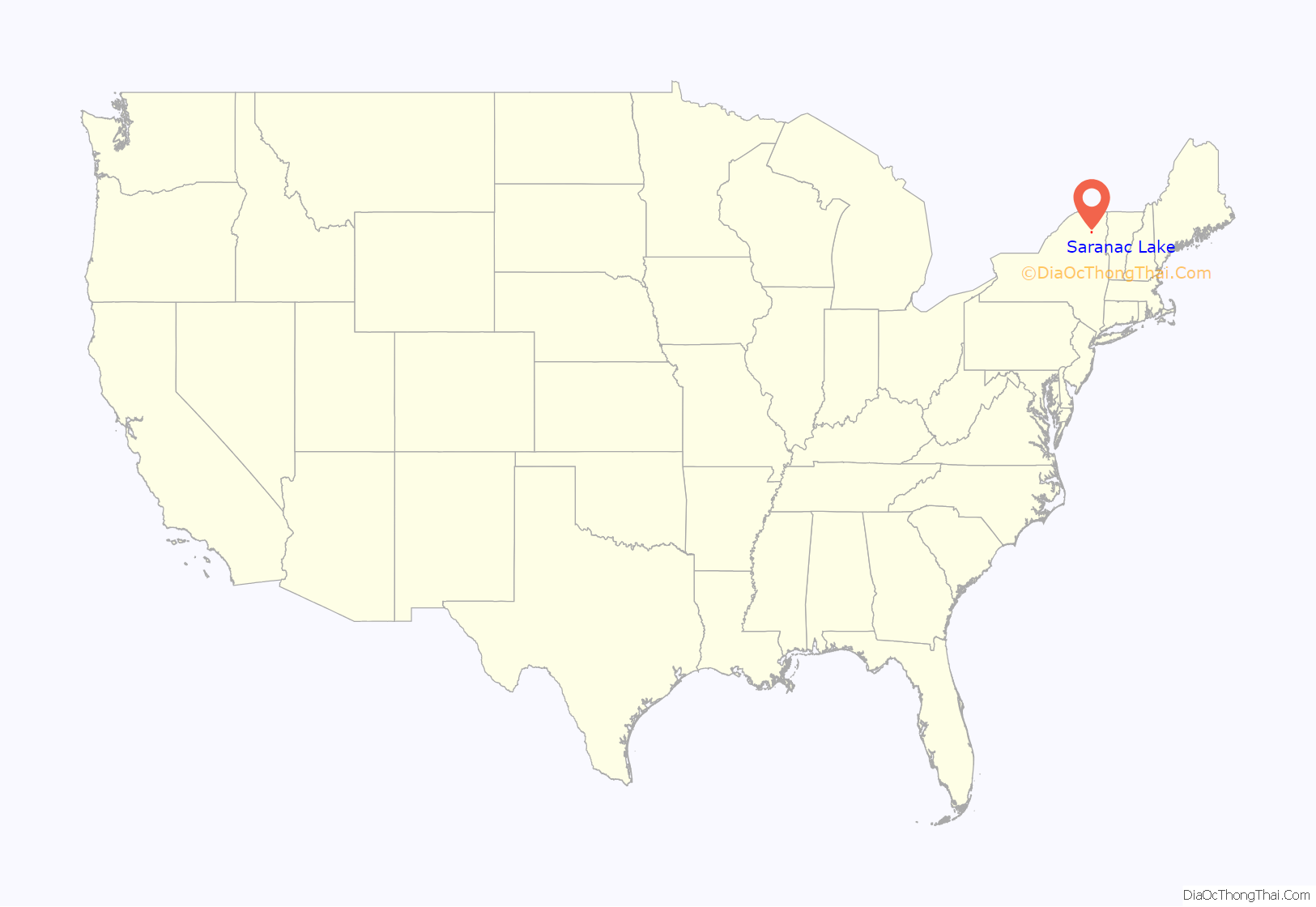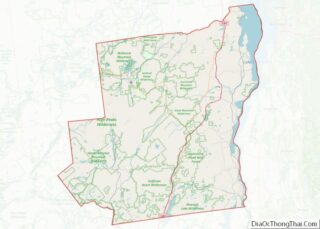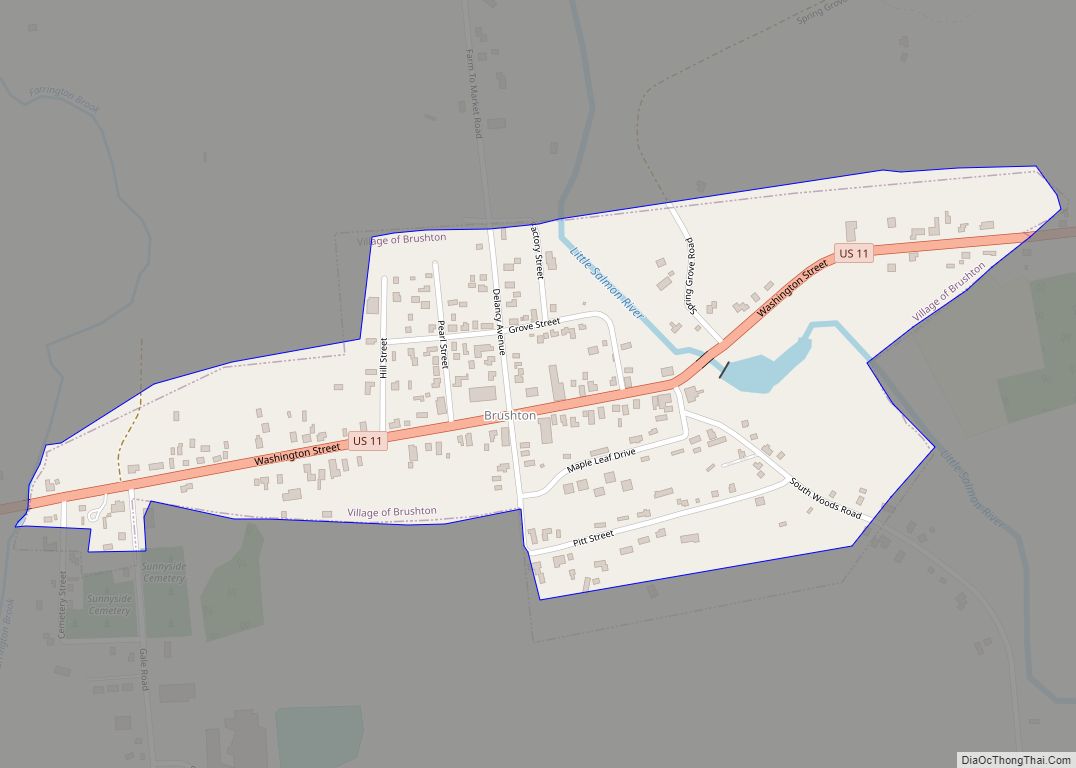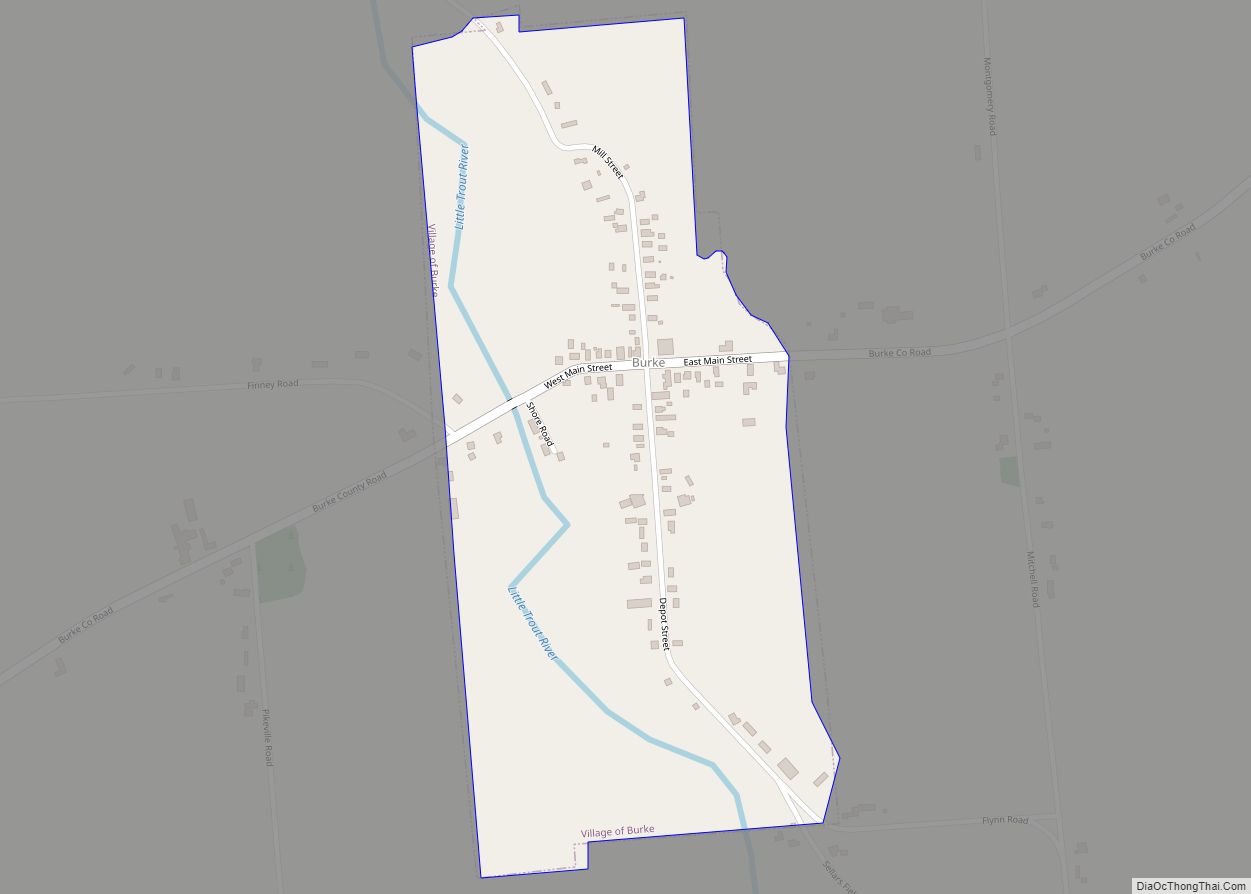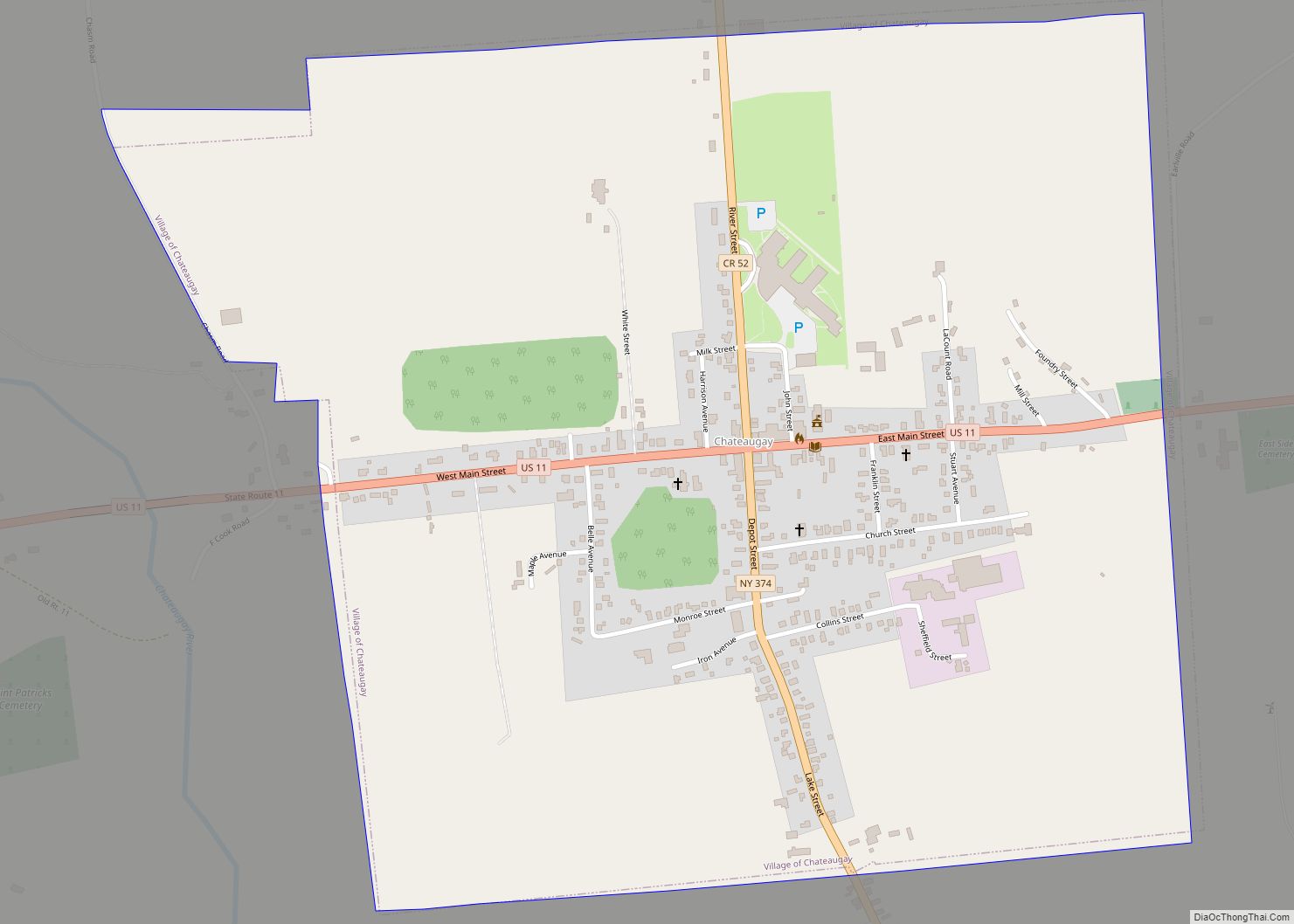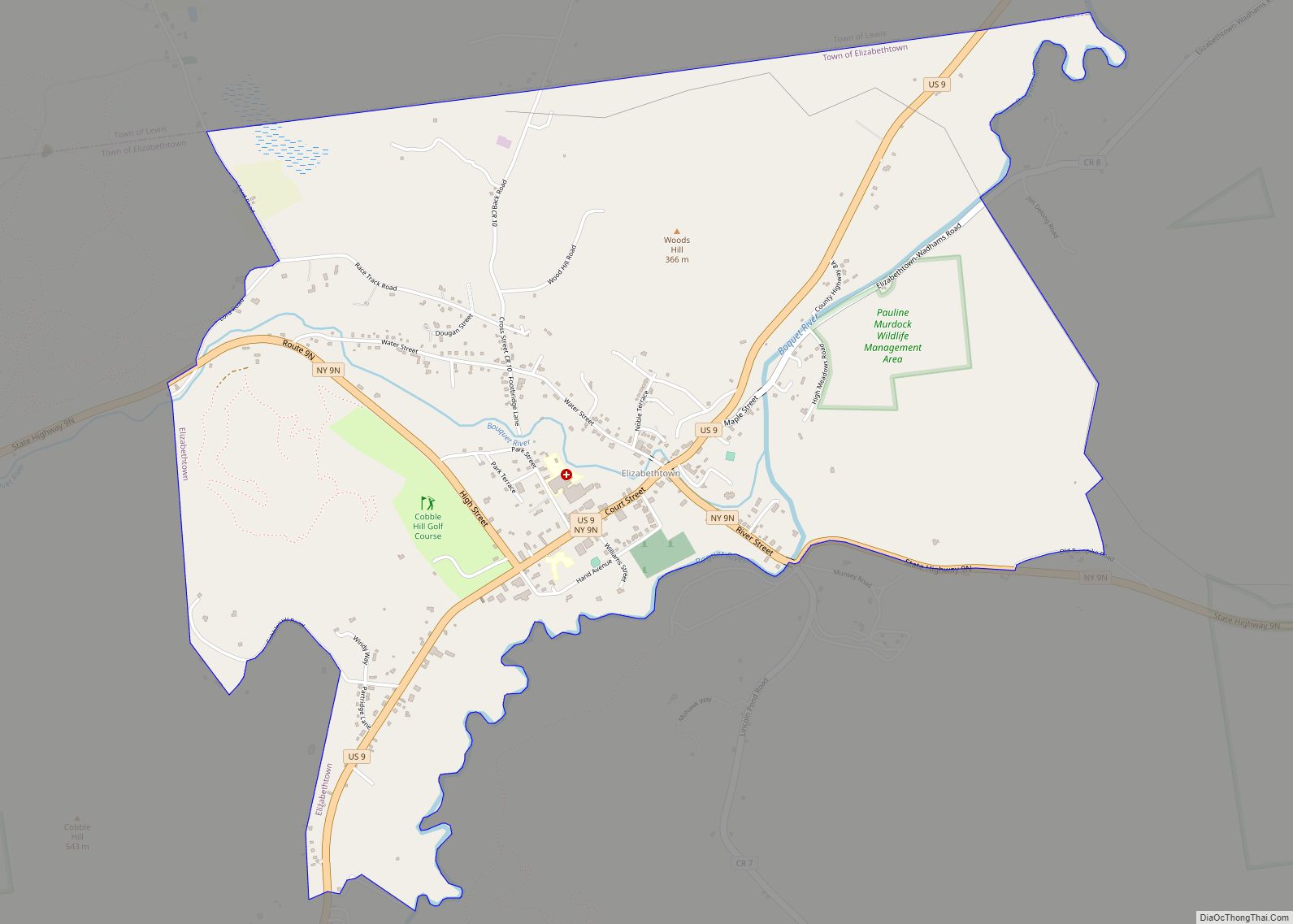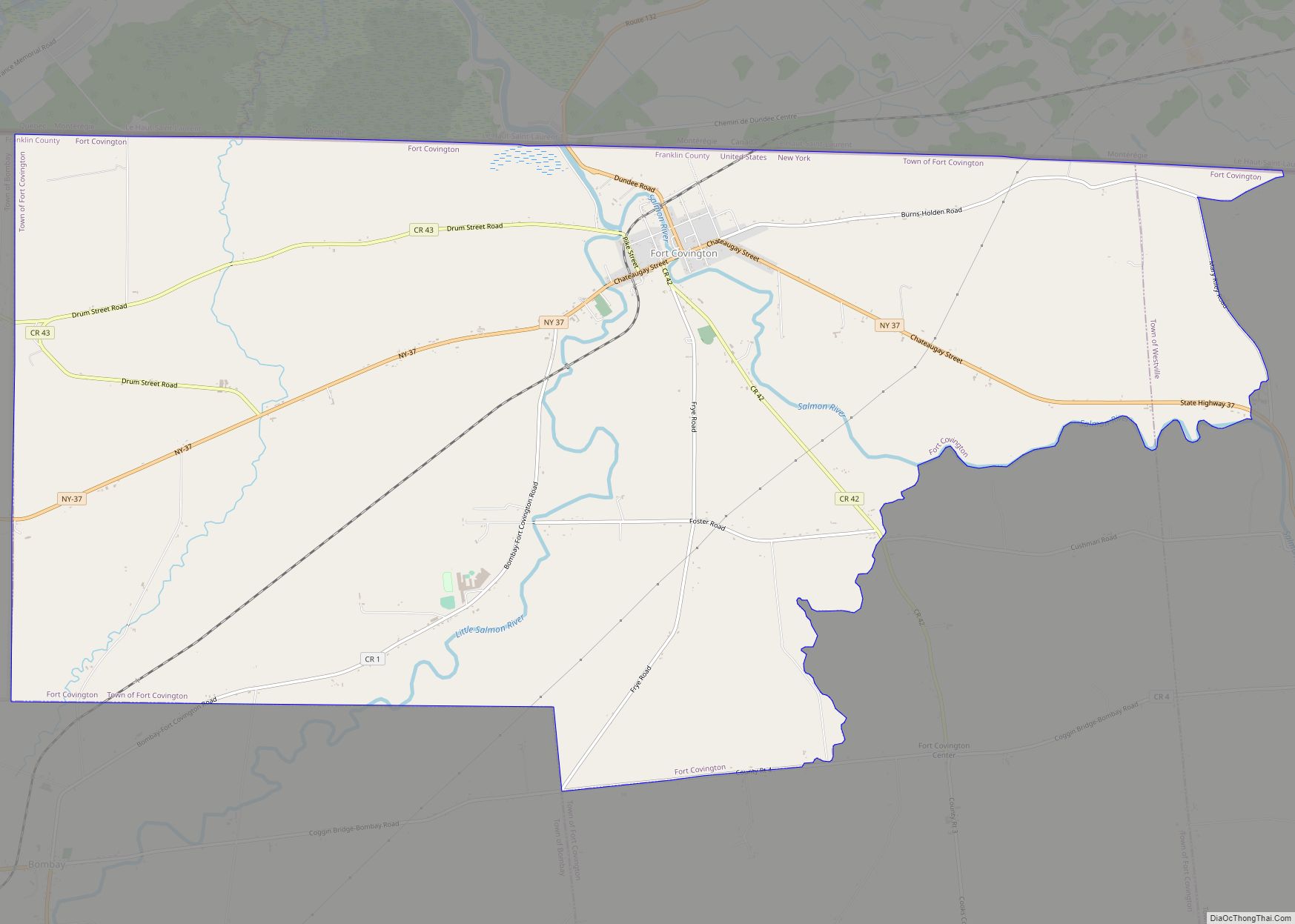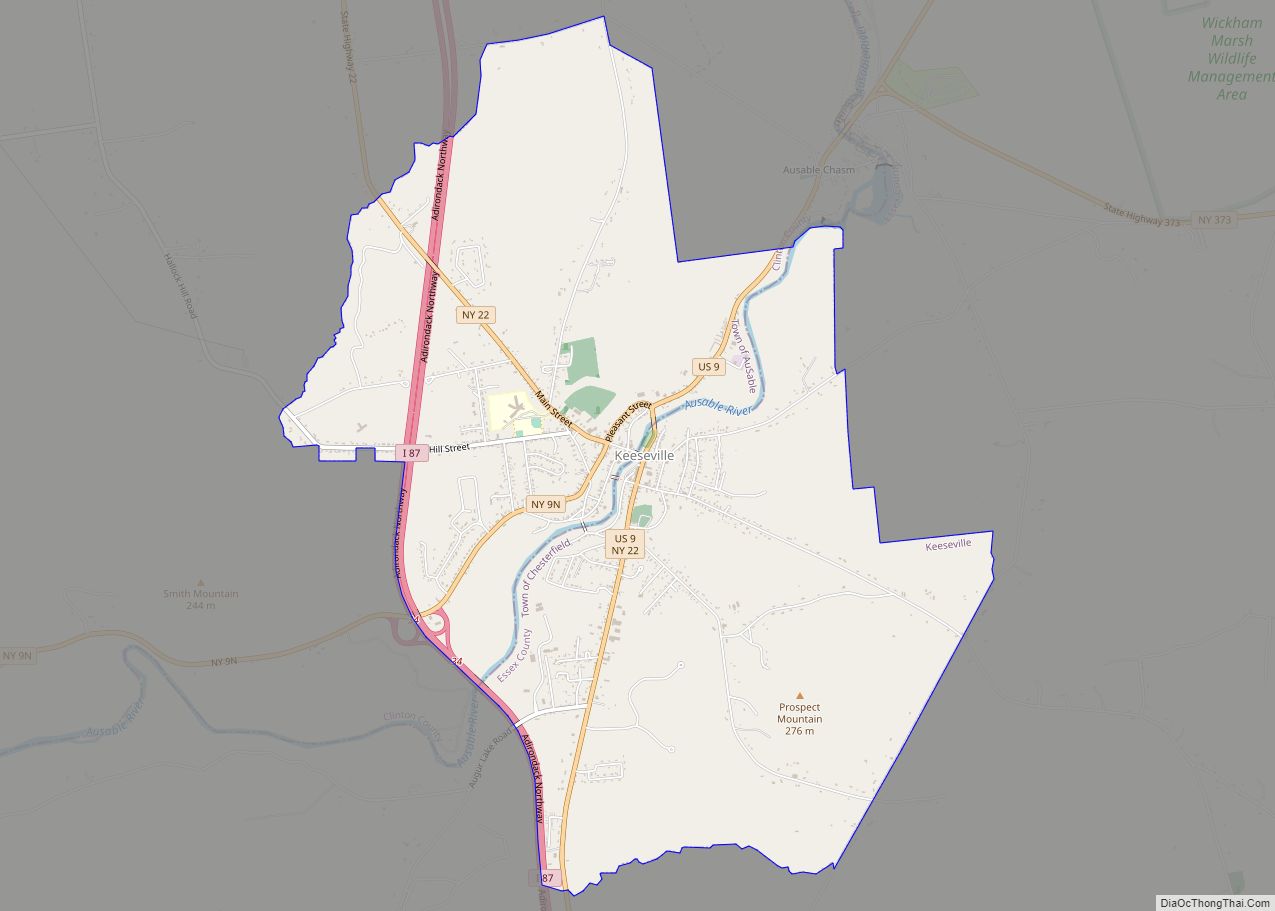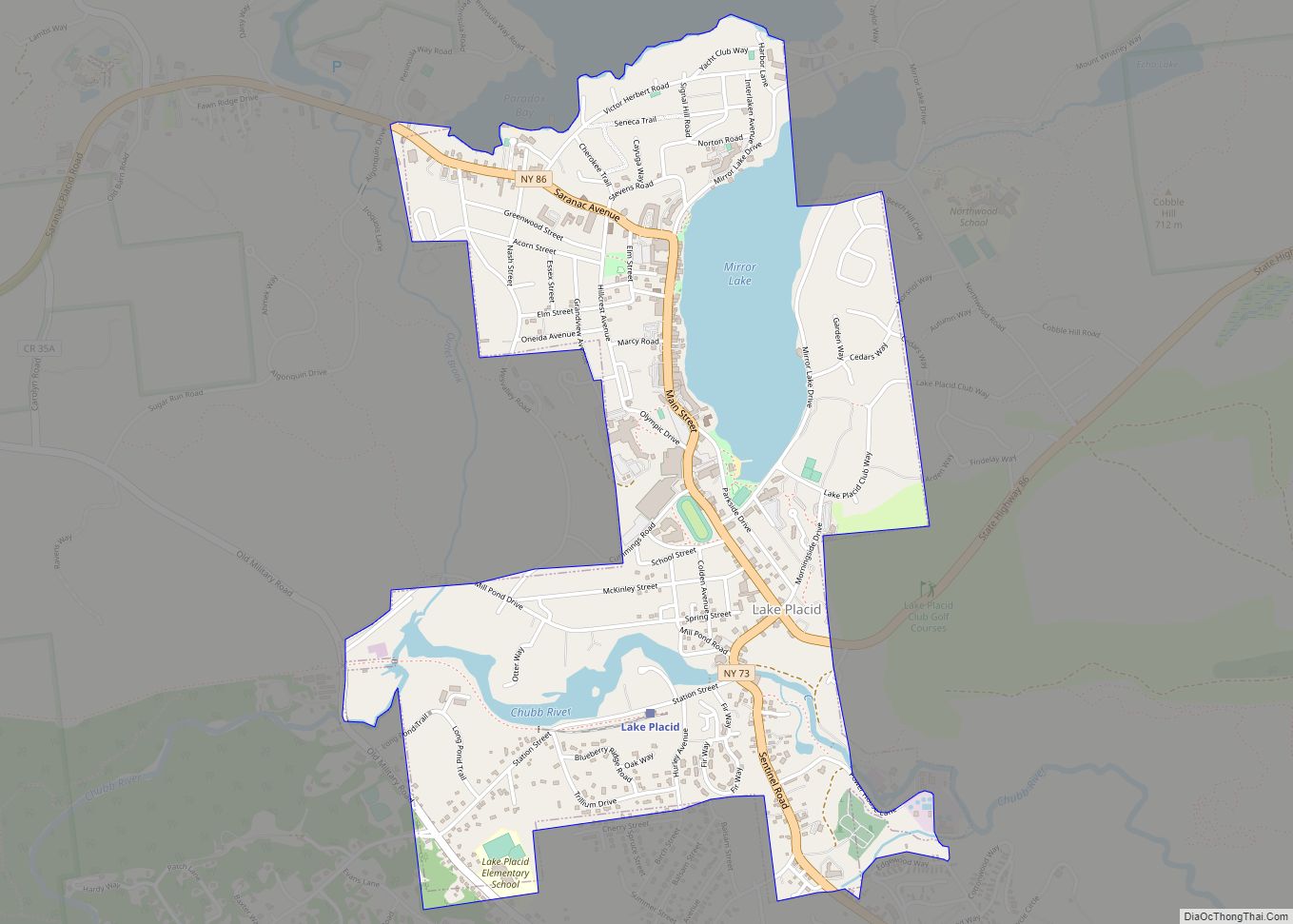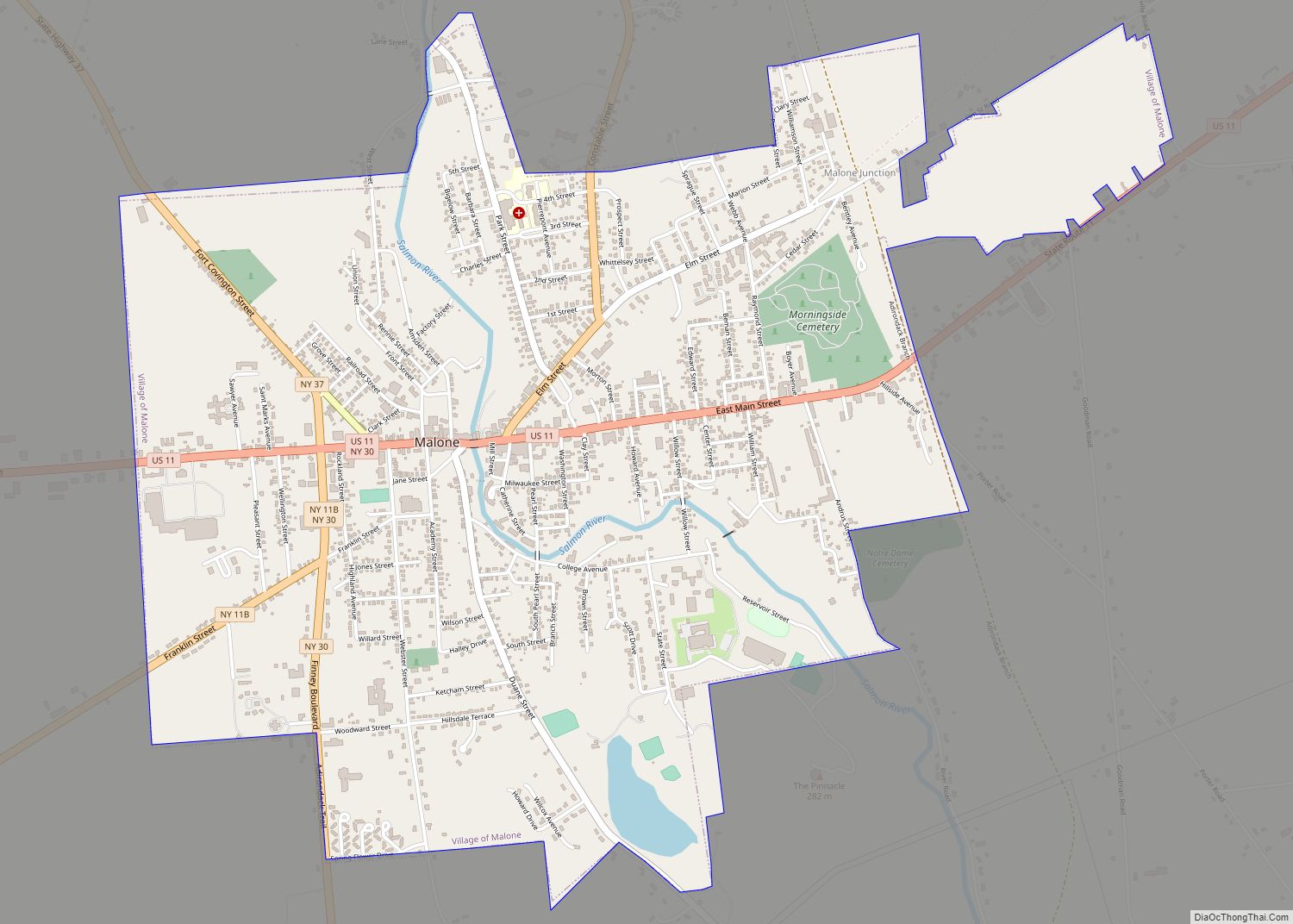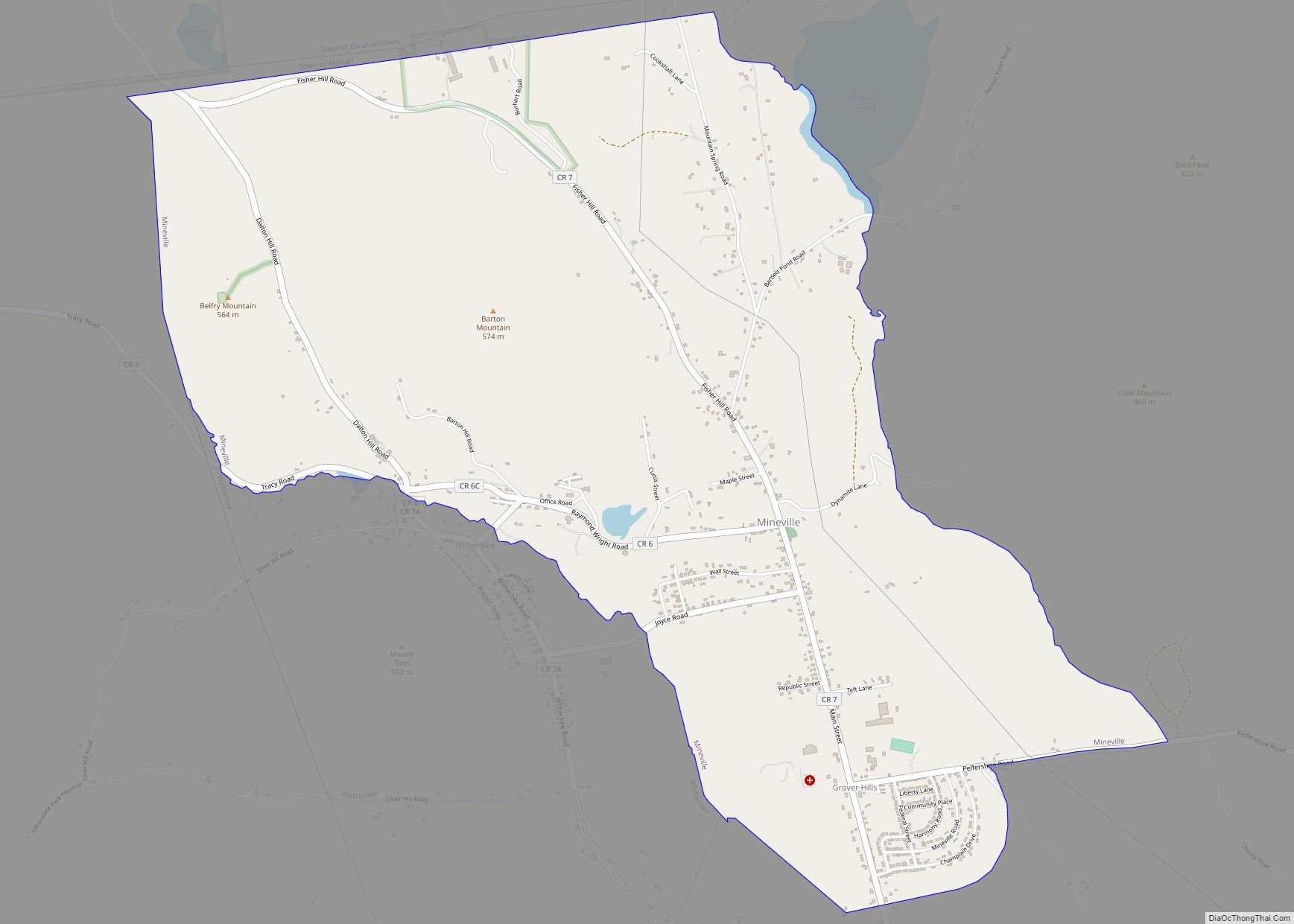Saranac Lake is a village in the state of New York, United States. As of the 2020 census, the population was 4,887, making it the largest community by population in the Adirondack Park. The village is named after Upper, Middle and Lower Saranac lakes, which are nearby.
The village of Saranac Lake covers parts of three towns (Harrietstown, St. Armand, and North Elba) and two counties (Franklin and Essex). The county line is within two blocks of the center of the village. At the 2010 census, 3,897 village residents lived in Harrietstown, 1,367 lived in North Elba, and 142 lived in St. Armand. The village boundaries do not touch the shores of any of the three Saranac Lakes; Lower Saranac Lake, the nearest, is a half mile west of the village’s downtown district. The northern reaches of Lake Flower, which is a wide part of the Saranac River downstream from the three Saranac Lakes, lie within the village. The town of Saranac is an entirely separate entity, 33 miles (53 km) down the Saranac River to the northeast.
The village lies within the boundaries of the Adirondack Park, 9 miles (14 km) west of Lake Placid. These two villages, along with nearby Tupper Lake, comprise what is known as the Tri-Lakes region.
Saranac Lake was named in 1995 the best small town in New York State and ranked 11th in the United States in The 100 Best Small Towns in America. In 1998, the National Civic League named Saranac Lake an All-America City, and in 2006 the village was named one of the “Dozen Distinctive Destinations” by the National Trust for Historic Preservation. 186 buildings in the village are listed on the National Register of Historic Places.
| Name: | Saranac Lake village |
|---|---|
| LSAD Code: | 47 |
| LSAD Description: | village (suffix) |
| State: | New York |
| County: | Essex County, Franklin County |
| Elevation: | 1,545 ft (471 m) |
| Total Area: | 3.16 sq mi (8.18 km²) |
| Land Area: | 2.91 sq mi (7.54 km²) |
| Water Area: | 0.25 sq mi (0.64 km²) |
| Total Population: | 4,887 |
| Population Density: | 1,678.80/sq mi (648.21/km²) |
| ZIP code: | 12983 |
| Area code: | 518 |
| FIPS code: | 3665233 |
| GNISfeature ID: | 0964482 |
| Website: | www.saranaclakeny.gov |
Online Interactive Map
Click on ![]() to view map in "full screen" mode.
to view map in "full screen" mode.
Saranac Lake location map. Where is Saranac Lake village?
History
This area was occupied by Iroquoian-speaking peoples for hundreds of years, and by other Indigenous peoples before them. The historic Mohawk people extended their hunting grounds to this area.
The area was first settled by European Americans in 1819, more than three decades after the American Revolutionary War. As the Iroquois, mostly allies of the British, had been forced to cede their land to the United States following the war, millions of acres of New York were opened up to non-Native development in the postwar period.
The Jacob Smith Moody family from Keene, New Hampshire, was the first to settle here. In 1827, settlers Pliny Miller and Alric Bushnell established a logging facility with a dam and sawmill, around which the village developed. The first school was built in 1838. In 1849, William F. Martin built one of the first hotels in the Adirondack Mountains. His Saranac Lake House, known simply as “Martin’s”, was located on the southeast shore of Lower Saranac Lake. Martin’s soon became a favorite place for hunters, woodsmen, and socialites to meet and interact.
In 1876, Dr. Edward Livingston Trudeau arrived from New York City to treat his tuberculosis (TB) by a stay in the mountains. There was no medical treatment other than rest and nutrition at the time, and the disease was often fatal. Dry, cold air was considered to be good for patients, and sanitariums were also founded in European mountain resorts. Trudeau discovered that the fresh air and dry, alpine climate improved his health. In 1884, he founded his Adirondack Cottage Sanitarium, starting with a small cottage, called “Little Red”. Two sisters from New York City who suffered from TB became the first patients. Little Red, the first “cure cottage”, was built on a small patch of land on the north side of Mount Pisgah. The plot had been purchased for Trudeau by several of his hunting guides.
As more patients visited the region, including author Robert Louis Stevenson in 1887, Trudeau’s fame grew. Soon, the sanitarium had grown to such size that it was entitled to its own post office, which delivered mail to the many patients. The Trudeau Institute, an independent medical research center, developed from Trudeau’s work for the sanitarium. In 1964, the Trudeau Institute began researching the functions of the immune system and how it guards against many infectious diseases, including tuberculosis.
William S. Fowler was a real estate speculator and developer who owned several properties around Saranac Lake. One was a large property just outside the town on top of a hill. He named it “Spion Kop” in honor of a battle that was fought in the Boer War in South Africa. In commemoration, he placed miniature cannons on various parts of the property.
Several buildings were erected as cottages where people could “cure” from TB. In 1919, Fowler sold the property to the Northwestern Fire Insurance Company. They turned it into a private sanatorium for their employees.
In 1925, the sanatorium was sold to the National Vaudeville Artists. Around this time there were numerous vaudeville performers in Saranac Lake seeking cures at different locations. E. F. Albee, the owner and President of the National Vaudeville Artists, held benefit programs in New York City to raise funds to construct the large sanitarium. The older cure cottages were torn down and some were moved. By the end of the 1920s the Tudor Building was completed. It still stands today.
In the 1930s the National Vaudeville Artists no longer existed. After World War II antibiotics were used to treat TB, and the mountain sanitariums were converted to other uses. The Tudor Building was purchased by the Will Rogers Memorial Commission. In 1936, one year after Rogers’ death, they renamed this building as the Will Rogers Memorial Hospital. A laboratory was built in later years and named the O’Donnell Memorial Laboratory in honor of R.J. O’Donnell, a well-known theater chain manager.
In the 1970s, New York State forced the closure of the hospital, as it did not meet contemporary codes and updating was cost-prohibitive. The Will Rogers building was adapted for other uses. It was operated as a night club, then as a timeshare vacation spot, and finally as apartments. Unable to attract enough renters, the owners abandoned the property, which deteriorated. In 1980, it was renovated for use as the press headquarters for the Winter Olympics. In 1995, the Kaplan Development Group purchased the property for adaptation as a retirement home for senior residents. It planned to restore the building’s historic details.
Telephone service was introduced in 1884, and the Chateaugay branch of the Delaware and Hudson Railroad reached Saranac Lake from Plattsburgh in 1887. Five years later, the Mohawk and Malone Railway main line reached nearby Lake Clear Junction. The New York Central and Hudson River Railroad purchased it in 1894, and it was merged into the New York Central Railroad in 1913. The NYC became the leading railroad from New York City, via Utica, into the northern Adirondacks, and its Lake Clear Junction-Saranac Lake-Lake Placid Branch was a key traffic source until NYC passenger service ended on April 24, 1965. Railroads both carried passenger traffic to the growing resort areas of the Adirondacks and shipped out the millions of feet of lumber that were harvested from this area into the early 20th century.
The village was incorporated on June 16, 1892, and Dr. Trudeau was elected the first village president soon thereafter. Electricity was introduced on September 20, 1894, by installing water wheels on the former site of Pliny Miller’s mill. Paul Smith purchased the Saranac Lake Electricity Co. in 1907, and formed the Paul Smith’s Electric Light and Power and Railroad Company. It eventually became part of Niagara-Mohawk. At the same time, the village began to develop municipal facilities, such as public schools, and fire and police departments.
In 1892, John Rudolphus Booth, the Canadian lumber king, rented a cottage at Saranac Lake for his daughter, who used it for several years in seeking a TB cure. Booth brought skis with him, and introduced the sport of skiing to the area.
Starting in the 1890s and for the next 60 years, Saranac Lake was known as “the Western Hemisphere’s foremost center for the treatment of pulmonary tuberculosis”. An effective antibiotic was first used on human TB patients in 1921, but only after World War II did it begin to be widely used in the US. In the postwar period, sanatorium treatment became less important and was phased out completely by 1954. Among the last of the prominent patients who sought treatment for tuberculosis was Manuel Luis Quezon y Molina, the first Filipino president of the Commonwealth of the Philippines, who died in Saranac Lake of the disease on August 1, 1944.
But the village had become a center of tuberculosis care, attracting many doctors and patients from around the world. They added to and supported the culture of the area, as did the wealthy who built Great Camps on the nearby Saranac and Saint Regis Lakes, the effect was to change the sleepy village of 300 of the 1880s into the vibrant “little city” of 8,000.
Author Mark Twain vacationed on Lake Flower in 1901 at the height of his fame. While there, he wrote a Conan Doyle spoof, “A Double-Barreled Detective Story”.
After multiple fires destroyed a large part of downtown, Saranac Lake rebuilt in the 1920s. The Hotel Saranac was built in the Art Deco style and still stands. Other permanent buildings were added to the townscape. During the Prohibition era, rum-running was common in the village, as smugglers brought liquor from over the border from Canada. Gangster Legs Diamond visited his brother Eddy, who had TB and stayed at a local cottage sanatorium. During the 1920s, entertainer Al Jolson and president Calvin Coolidge were semi-frequent visitors to the village; Jolson once performed a solo for three hours at the Pontiac Theater on Broadway.
Beginning in 1936, physicist Albert Einstein had a summer home in Saranac Lake, renting the cottage of local architect William L. Distin; he often sailed with his wife on Lake Flower. During World War II, Einstein summered frequently at Knollwood Club on Lower Saranac Lake. He heard with others from the radio that on August 6, 1945, the atom bomb had been dropped on Hiroshima. A few days later, Einstein gave his first interview about this event at Knollwood.
In 1954, Saranac Lake hosted the world premiere of the Biblical epic film The Silver Chalice, in which actor Paul Newman made his debut. Several of the stars, including Virginia Mayo, visited the village and participated in the winter carnival parade.
Since the late 20th century, Saranac Lake has become a more conventional tourist destination. New York’s former governor, Andrew Cuomo, has visited there ever since he was a teenager and regularly vacations there with his family. The Hotel Saranac is a memorable early 20th century Art Deco structure. The former sanatorium is now used as the corporate call center for the American Management Association.
Numerous properties are listed on the National Register of Historic Places: the Dr. A. H. Allen Cottage, Berkeley Square Historic District, Bogie Cottage, Peyton Clark Cottage, Coulter Cottage, Cure Cottage at 43 Forest Hill Avenue, Denny Cottage, Fallon Cottage Annex, Freer Cottage, Hathaway Cottage, Helen Hill Historic District, Highland Park Historic District, Hill Cottage, The Homestead, Kennedy Cottage, Lane Cottage, Larom Cottage, Dr. Henry Leetch House, Lent Cottage, Little Red, Marquay Cottage, Marvin Cottage, Musselman Cottage, New York Central Railroad Adirondack Division Historic District, Partridge Cottage, Pittenger Cottage, Pomeroy Cottage, Will Rogers Memorial Hospital, Orin Savage Cottage, Paul Smith’s Electric Light and Power and Railroad Company Complex, Prospect Point Camp, Stevenson Cottage, Stuckman Cottage, Trudeau Sanatorium, Chester Valentine House, Wilson Cottage, and Witherspoon Cottage.
Saranac Lake Road Map
Saranac Lake city Satellite Map
Geography
Saranac Lake is located at 44°19′34″N 74°7′51″W / 44.32611°N 74.13083°W / 44.32611; -74.13083 (44.325988, −74.130944).
According to the United States Census Bureau, the village has a total area of 3.0 square miles (7.8 km), of which 2.8 square miles (7.2 km) is land and 0.23 square miles (0.6 km), or 8.21%, is water.
The village is located at the junction of the towns of North Elba and St. Armand in Essex County, and Harrietstown in Franklin County.
The village is at the intersection of New York State Route 3 and New York State Route 86. Essex County Road 33 enters the village from the southeast, Franklin County Road 47 joins NY-86 immediately north of the village, and Franklin County Road 18 connects from Ampersand Avenue on the northern edge of the village to New York State Route 30 near near Saranac Inn, New York.
The closest major metropolitan city is Montreal, Quebec, Canada, 103 miles (166 km) to the north. Plattsburgh is 50 miles (80 km) to the northeast, Burlington, Vermont, is 69 miles (111 km) by road to the east and Albany is 148 miles (238 km) to the south.
See also
Map of New York State and its subdivision:- Albany
- Allegany
- Bronx
- Broome
- Cattaraugus
- Cayuga
- Chautauqua
- Chemung
- Chenango
- Clinton
- Columbia
- Cortland
- Delaware
- Dutchess
- Erie
- Essex
- Franklin
- Fulton
- Genesee
- Greene
- Hamilton
- Herkimer
- Jefferson
- Kings
- Lake Ontario
- Lewis
- Livingston
- Madison
- Monroe
- Montgomery
- Nassau
- New York
- Niagara
- Oneida
- Onondaga
- Ontario
- Orange
- Orleans
- Oswego
- Otsego
- Putnam
- Queens
- Rensselaer
- Richmond
- Rockland
- Saint Lawrence
- Saratoga
- Schenectady
- Schoharie
- Schuyler
- Seneca
- Steuben
- Suffolk
- Sullivan
- Tioga
- Tompkins
- Ulster
- Warren
- Washington
- Wayne
- Westchester
- Wyoming
- Yates
- Alabama
- Alaska
- Arizona
- Arkansas
- California
- Colorado
- Connecticut
- Delaware
- District of Columbia
- Florida
- Georgia
- Hawaii
- Idaho
- Illinois
- Indiana
- Iowa
- Kansas
- Kentucky
- Louisiana
- Maine
- Maryland
- Massachusetts
- Michigan
- Minnesota
- Mississippi
- Missouri
- Montana
- Nebraska
- Nevada
- New Hampshire
- New Jersey
- New Mexico
- New York
- North Carolina
- North Dakota
- Ohio
- Oklahoma
- Oregon
- Pennsylvania
- Rhode Island
- South Carolina
- South Dakota
- Tennessee
- Texas
- Utah
- Vermont
- Virginia
- Washington
- West Virginia
- Wisconsin
- Wyoming
